
Microphones can serve a variety of uses, but a truly excellent microphone will excel at all forms of audio recording. Plus, the best part is that you won’t have to break the bank to get this kind of versatility.
USB microphones are a great addition to any PC setup, as these plug-and-play peripherals can produce studio-level sound without needing a professional mixing board.
We’ve compiled a top ten list featuring some of our favorite microphones for any use across all price ranges. This assortment of microphones can be used to record vocals, musical instruments, podcasts, voiceovers, interviews, or chat conference calls and games.
From extra sensitive condenser mics to crystal clear dynamic mics, the whole gamut of consumer recording gear is at your disposal, and even the most affordable of them has the flexibility to do it all. Read on below to see our picks for the best USB microphones.
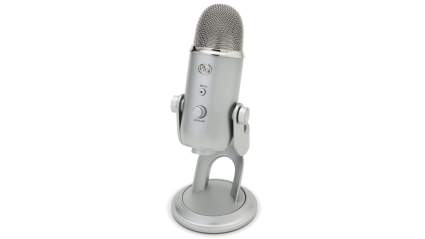
|
Amazon Customer Reviews
|
Price: $97.43 Shop at Amazon | Shop now Read our review |

|
Amazon Customer Reviews
|
Price: $202.36 Shop at Amazon | Shop now Read our review |
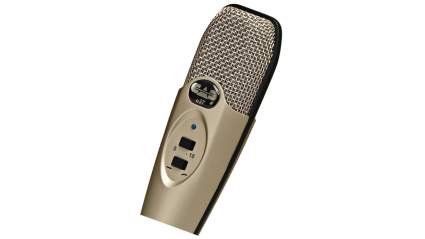
|
Amazon Customer Reviews
|
Price: $39.99 Shop at Amazon | Shop now Read our review |
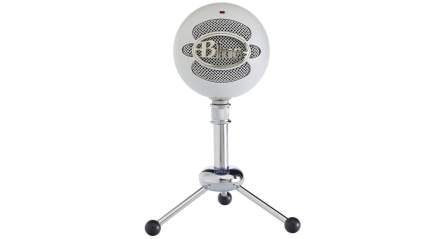
|
Amazon Customer Reviews
|
Price: $119.00 Shop at Amazon | Shop now Read our review |
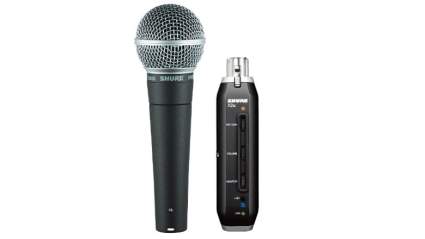
|
Amazon Customer Reviews
|
Price: $228.95 Shop at Amazon | Shop now Read our review |
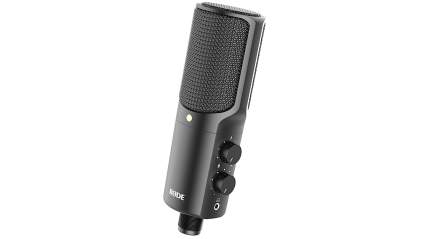
|
Amazon Customer Reviews
|
Price: $169.00 Shop at Amazon | Shop now Read our review |
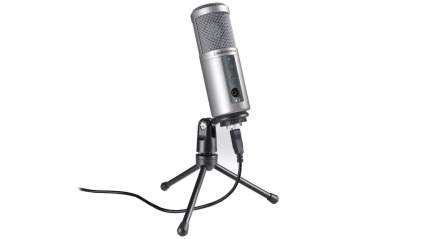
|
Amazon Customer Reviews
|
Price: $29.59 Shop at Amazon | Shop now Read our review |
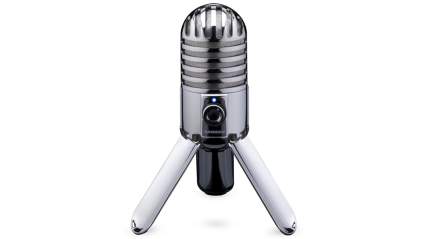
|
Amazon Customer Reviews
|
Price: $29.99 Shop at Amazon | Shop now Read our review |

|
|
Price: No price available Shop now at amzn.to | Shop now Read our review |
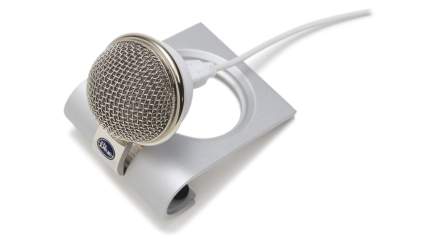
|
Amazon Customer Reviews
|
Price: $49.95 Shop at Amazon | Shop now Read our review |
-
1. Blue Microphones Yeti USB
Pros:- Tri-capsule array allows for versatile recording
- Gain control and headphone output allow for on the go adjustment
- Plug and play
Cons:- Large and heavy form is hard to pack along
- Thumbscrews on stand come loose easily
- No good place to attach a pop filter
The Yeti USB from Blue Microphones is easily one of the best USB microphones out there. This not only due to its incredible recording quality, but also because of the Yeti’s sheer versatility.
Despite standing 10 inches tall, the mic on its stand has a small footprint that encourages desktop use. But its heavy metal construction and standard threaded mount for larger stands means that it can easily survive the abuse of either the stage or the studio to match.
The real reason that the Yeti is so flexible, though, is its three condenser capsules, which work together to create four different recording patterns that mimic multi-mic setups.
Stereo mode uses the L/R channels to capture a realistic sound image, cardioid mode records rich, full-bodied sounds head-on, omnidirectional mode captures all-around sound and ambiance, and bidirectional mode captures from the front and rear to assist with one on one interviews.
Each mode sounds great for its proper use and produces high-quality digital recordings with a max sample rate of 48kHz and bit rate of 16. Recording is easy, as the mic is plug and play, and user controls are very intuitive. The volume knob and mute button feel nice, as do the gain knob and pattern selection knob. The microphone has a headphone jack for zero-latency playback.
The only downside to the form factor (besides the fact that it almost weighs 4 pounds) is that the thumbscrews which connect the mic to the stand come loose pretty easily.
And while it may have to do with my choice of pop filter, I have trouble finding a place for my gooseneck-style filter on the stand. A more flexible pop filter will grip to the stand without issue, but these gripes aside, the Yeti is a fantastically well-built piece of equipment.
The original Yeti works great for strictly computer-based work, but if you expect to use your mic with analog equipment such as a professional mixing board, you will want to upgrade to the Yeti Pro, which offers dedicated XLR output in addition to USB output, plus a higher maximum recording resolution of 192 kHz/24-bit. But either one is a great choice, as is pretty much every Blue microphone across the price spectrum.
Find more Blue Microphones Yeti USB information and reviews here.
-
2. Audio-Technica AT2020USB PLUS
Pros:- Small and durable design
- Volume-adjustable headphone monitoring
- Mic control allows you to blend mic signal and other audio
Cons:- Included tripod is somewhat weak
- Extra sensitive condensers need a pop filter
- No vibration dampening
Thanks to their ever-popular AT2020USB PLUS, Audio-Technica continues to earn high marks for nearly every variety of musical product they manufacture. From headphones to turntables, to microphones, AT knows how to make a quality piece of equipment, and the powerful AT2020USB is yet another testament to this fact.
This microphone is characterized by a spartan design with a single blue LED for a centerpiece. The AT2020 is compact, durable, and works with any sort of threaded stand, not just the squat adjustable tripod that comes with it. The included swiveling tripod stand is a little flimsy, and does nothing to dampen vibrations from your desk, so you’ll want a sturdier stand if you have an HDD running anywhere near where you set this up.
Unlike AT’s previous model (which is reviewed in the video above), the PLUS version has a headphone jack for self-monitoring and a volume control that helps you blend your microphone signal and pre-recorded audio. Audio is digitized in a max recording resolution of 48 kHz/16-bit, exceeding CD fidelity.
The mic’s cardioid pickup eliminates a lot of ambient sounds that come from outside of the 45° (or so) angle where the diaphragm faces, but the mic is very sensitive to noise from within this area. This condenser mic is almost too sensitive, as it easily picks up plosives (“B”, “P”, and “D” sounds). A pop filter is a cheap and easy fix though.
For the price, the AT2020USB PLUS is an outstanding value, and if you are after studio-quality sound in a convenient digital form factor, then this microphone is a great pick.
Find more Audio-Technica AT2020USB PLUS information and reviews here.
-
3. CAD U37 USB Studio Condenser
Pros:- Low price
- Overload protection and bass reduction switches
- Solid sound quality
Cons:- Some playback latency when recording
- Included tripod is somewhat weak
- No monitoring feature
If your goal is to produce high-quality audio on a budget, the CAD U37 is going to offer the best bang for your buck. This entry-level condenser microphone is loaded with value, offering 48 kHz/16-bit sound and handy controls for a very reasonable price.
The U37 is a side-address microphone with a large condenser element beneath its grill. This offers warm and rich recordings, and the mic is able to pick up the smallest nuances, as sensitive condensers are known to do. Compared to more high-end microphones, the CAD U37 does have a bit of latency when running through audio software, but there are many other factors that contribute to this.
Its cardioid pickup pattern minimizes background noise and isolates the main sound source, and a built-in bass reduction switch improves noise reduction even more. This mic also has a 10dB overload-protection switch which can be used to minimize distortion from loud sound sources.
The collapsible plastic stand allows you to angle the mic on one axis but does have any shock damping capabilities. It is overall, a fairly mediocre way to hold up the mic. The mic body itself is plastic and lightweight, but still of fairly good quality. The small size makes it easy to put away, but it will also leave you wanting to add more sound isolation in your recording space.
All in all, the CAD U37 proves that you don’t have to spend top dollar to get one of the best USB microphones. Sure, spending a little more will you get you a better mic, but how much better?
Find more CAD U37 USB Studio Condenser information and reviews here.
-
4. Blue Microphones Snowball USB Microphone
Pros:- Dual capsule array allows for versatile recording
- -10dB pad helps capture loud signal
- Sturdy desktop stand
Cons:- Low recording level
- Cheap plastic casing
- Stand still needs shock absorption
Another much-loved microphone from Blue, the Snowball, offers fierce competition in the value department, employing a dual capsule design that gives you more control over your sound. The Snowball has both cardioid and omnidirectional elements beneath its grille, and a switch on the back lets you change from one pickup pattern to the other. Between these two modes is a second cardioid mod with a -10dB pad, which makes it easier to capture louder input without peaking.
The sound quality out of all three of these is great at a resolution of 41 kHz/16-bit, but the cardioid delivers the better frequency range between the two. Granted, the omnidirectional mode has its uses, but you will likely spend most of your time using this mic on one of the two cardioid modes.
One issue with the sound is that the recording level is comparatively low, meaning you will need to speak closer to the mic to get good volume in your recordings. It is also relatively easy to boost gain post-recording without distorting your sound.
Looking past the sound quality, the Blue is decently built as well. The plastic casing is durable enough, even though it feels somewhat cheap. The included mic stand is decent, and actually made of better quality material than the microphone’s casing, but it still lacks shock absorption.
As a middle of the road option, the Snowball can produce some high-quality audio, but won’t have all the bells and whistles a power user might want. Still, it is a huge improvement over built-in mics and will suffice for most any in-home use.
Find more Blue Microphones Snowball USB Microphone information and reviews here.
-
5. Shure SM58-X2U Cardioid Dynamic Microphone
Pros:- Durable shock-resistant design
- Smooth dynamic sound picks up less room noise
- Custom tailored sound for vocals
Cons:- Must ship with a mixer or XLR-to-USB adapter for digital use
- Needs to be held close to mouth for full sound
- On/off switch costs extra
The Shure SM57 is one of the most versatile and iconic dynamic microphones in existence, and its fraternal twin, the SM58, is a remake that is specifically tailored for vocals. Aside from the different grille shapes, these two are identical, right down to the recording element used in both models.
The SM57/58 were originally intended for studio use, but then quickly became a hit onstage. Now they are most popular in the home, where countless home enthusiasts are using it for podcasts, voice-over work, and recording vocals. This version of the SM58 ships bundled with a X2U XLR-to-USB adapter, which allows this analog microphone to connect directly to a PC. This effect can also be achieved with a USB mixer if you already own one.
The X2u is a plug and play device that offers flexible conversion of an analog XLR signal into a digital USB signal. This device offers 48 kHz/16-bit sound, with an integrated preamp, microphone gain controls, zero latency monitoring, and a monitor mix control. It’s basically a one track mixer that you can take with you anywhere, and it adds lots more control into a home recording setup.
As for the mic itself, the SM58 is hands down one of the best picks for vocals. Though its frequency range is smaller than other microphones, its frequency response is custom tailored to the human vocal range. This means you will hear a brightened midrange and a moderate amount of bass roll-off. Whether your voice is high or low, the SM58 will pick up its full detailed richness. Beneath this mic’s steel mesh grille is a built-in screen that means you won’t need a pop filter.
This is a dynamic microphone rather than another condenser microphone, which offers some nuanced differences in sound. While overall fidelity remains the same, the dynamic sound is far less sensitive to background noise. And likewise, the sound is a little smoother and less harsh. Both sound great for vocals, and your choice ultimately comes down to personal preference.
An addition to sounding good, the SM58 is also durable, sporting a pneumatic shock-mount system to reduce handling noise when you are holding the mic. And there will be plenty of holding the mic, as you have to have it as close to your mouth as possible for the full sound you want. This can create a challenge out of some uses, but also, feels great on stage, and really helps connect you to the gear.
Feel comfortable, packing, spinning, and fist-pumping with this mic, as the SM58 can handle the roughest nights onstage. These mics are known for lasting lifetimes and are easily repairable due to the fact that every gear expert out there has used one. Sure, it won’t be the first pick for the user who wants a convenient do-it-all microphone, but for those who plan to keep a microphone collection someday, this classic model is absolutely indispensable.
Find more Shure SM57-X2U Cardioid Dynamic Microphone information and reviews here.
-
6. Rode NT-USB USB Condenser Microphone
Pros:- Included pop filter
- Low noise floor
- Mic control allows you to blend mic signal and other audio
Cons:- No gain control
- Included tripod is somewhat weak
- Competes with models that offer multiple pickup patterns
The NT-USB from Rode is a versatile side-address microphone that offers clear recording and high usability in a sleek and attractive package. The NT-USB is in the same price tier as some of the biggest names in the consumer microphone sphere but still manages to stand alone as one of the best USB microphones in its price range.
Most notable on the sturdy full-metal design is that this mic actually comes with a pop filter that is designed to perfectly cover the grille of the mic. It also includes a rubber-footed tripod stand and a long twenty foot USB cable.
This condenser microphone is surprisingly well-tuned, as it seems to pick up voices much better than ambient sounds thanks to a slight bump in its upper midrange. The cardioid pickup pattern helps with this and contributes a very low background noise level. The max digital resolution is an excellent 48 kHz/16-bit.
One thing that stands out between the NT-USB and other mics in its price range is that they typically offer different pickup patterns besides cardioid mode. The Rode still sounds good in a variety of uses though, so this shouldn’t be an issue unless there is a specific reason you need omnidirectional mode.
On the side is a headphone jack for no-latency monitoring and a quality volume knob for the monitor. The microphone also has a mixer control that lets you blend the monitor sound over the pre-recorded audio from your computer. Sadly absent from the knob selection is any gain control, which makes it harder to record particularly loud or quiet sources.
All in all, the Rode NT-USB still competes in quality with some of the biggest names in prosumer microphones. It might be light of a couple really nice features, but it still offers great recording quality and a fantastic build.
Find more Rode NT-USB USB Condenser Microphone information and reviews here.
-
7. Audio-Technica ATR2500-USB
Pros:- Low price
- High digital resolution
- Volume-adjustable headphone monitoring
Cons:- Cheap plastic casing
- Included tripod is very weak
- Extra sensitive condensers need a pop filter
For those who are considering Audio-Technica’s AT2020USB but can’t justify the purchase, AT’s ATR2500-USB is a godsend of value. For half the price of the AT2020, the ATR2500 offers near equivalent sound quality in the same side-address condenser style.
If you went off of just sound quality alone, you might have trouble telling the two apart, as they both have the same maximum digital resolution of 48 kHz/16-bit. They also have the same sound signature, which includes a somewhat exaggerated low end that is complemented by a slight bump in the high midrange.
The sound is full and gets only slightly more background noise than its sensitive older brother. The cardioid pickup pattern on both of these microphones help, but they are both still ideal candidates for a pop filter. The microphones have a built-in headphone jack helps with monitoring as you record, although the monitor volume buttons are plastic and they feel low quality.
The microphone casing itself is seemingly equal parts metal and plastic, but despite corners cut in the form factor, the ATR2500 still gets the job done. It comes with a fairly low-quality stand and tripod, so the mic will make noise when your desk is bumped, but this is to be expected at this price range.
The ATR2500-USB is fairly no-frills when it comes to digital microphones, but it gets the job done for a more than fair price. As long as cosmetic factors like “knobfeel” are far from the top of your priority list, your money will be well-spent on yet another great piece of Audio-Technica gear.
Find more Audio-Technica ATR2500-USB information and reviews here.
-
8. Samson Meteor Mic USB Studio Microphone
Pros:- Low price
- Smooth and flat frequency response
- Low profile portable design
Cons:- Prone to occasional feedback
- Needs updated drivers for Windows 10
- Sound studio software costs extra
Samson has always been consistent in offering high-quality audio equipment at a price any musician can afford. Their Meteor mic is a compact option for desktop recording that doesn’t sacrifice quality for portability.
The Meteor presumably gets its name from the shape of the mic when its built-in folding legs are down. The Meteor looks beautiful with the rubber-padded legs, but they are fully removable if you want to replace them with a proper stand (and you probably should).
Being a lower profile device, it doesn’t pack on too many extra features, but you at least get a headphone jack for sound monitoring. You also get a small volume knob for the monitor and a mute switch.
Another very important thing that you get out of the Meteor is quality sound. This condenser mic packs a particularly large 25mm diaphragm, which adds a richness to its recordings that smaller elements can’t reproduce. Samson offers a small suite of sound software to complement this mic (including a digital noise reduction software), but it does not come bundled with the mic, so budget accordingly.
The Meteor has a cardioid pickup pattern, which works pretty well from a distance without inviting in too much ambient noise. Its sound signature is balanced, and the mic sounds smooth across its frequency spectrum. You can get reliable DVD-quality sound from this guy with a digital resolution of 48 kHz/16-bit.
For the amazing value that Samson packs into their Meteor, there is very little downside to this microphone. The price is right, and the microphone probably does everything you need it to do.
Find more Samson Meteor Mic USB Studio Microphone information and reviews here.
-
9. Razer Seiren X USB Digital Microphone
Price: No price availablePros:- Tri-capsule array allows for versatile recording
- LED display for volume, gain, and recording pattern
- 192 kHz/24-bit max recording resolution
Cons:- Bulky design has a large footprint
- Included software is useless
- So-so stand
The Razer Seiren Elite is a high-quality microphone that does everything you need it to, and more. Unfortunately, this microphone cannot match the low prices of its competitors, and therefore loses out big time. Still, if pricing is not an obstacle, the Seiren Elite makes a fantastic addition to any podcasting, gaming, or music recording setup.
The Seiren Elite is the largest microphone on this list, and including its boom stand, can take up quite a bit of desk space. But with this larger size comes an incredibly sturdy metal casing and grille, and a thread mount for stands and pop filters.
The backside is occupied by a giant LED logo which can be switched off, while the front side has a handy LED screen to display volume, gain, and recording pattern.
Volume refers to headphone monitoring, for which you have a zero-latency jack to plug into, gain is controlled by an easily accessible knob, and several recording patterns are available.
Like the Blue Yeti Pro (the value-packed competitor to this unit), the Seiren Elite can record in cardioid, stereo, omnidirectional, and bidirectional patterns, each one with its own unique uses.
And no matter which of these three 14mm condenser capsules you are using, the microphone sounds great, achieving a digital sample rate of up to 192 kHz/24-bit.
The Seiren Elite comes with a proprietary software whose sole purpose is to change the bit rate and sampling rate, and were it not able to unlock this high fidelity digital quality, would be not even worth installing.
But it does, which may put the Seiren Elite a nose ahead of the powerhouse Blue Yeti in your books. Both microphones have a unique set of features that make them worthwhile, but with the lower price tag and better reputation of the Yeti, the Seiren Elite won’t always look like the winner. But rest assured, either of these microphones is a fabulous pick.
Find more Razer Seiren X USB Digital Microphone information and reviews here.
-
10. Blue Microphones Snowflake USB Microphone
Pros:- Low price
- Solid recording quality
- Low profile portable design
Cons:- Not compatible with shock resistant stands
- Does not fit on every PC monitor
- Sensitive to background noise
At the low end of the Blue family lies the humble Snowflake. Though it lacks the sheer audio quality of their Snowball or the mammoth size of their Yeti, it is still a perfectly good sounding microphone, especially for its price. The Snowflake offers 44.1 kHz/16-bit resolution like the best of ’em.
The Snowflake’s funky design takes some getting used to, but is intended to hang over the backside of your monitor for easy use at a computer. This compact unit does not have threading to be mounted on a shock-resistant stand, so you are left vulnerable to some occasional desk rumble because of its all-metal stand.
Looking past the noise floor, the Snowflake still has a nice sound to it. It has a fairly flat frequency response, and can still pick up a quiet source without needing gain control thanks to its cardioid design. This is microphone is still a huge upgrade from integrated microphones no matter what device they’re on, but it does have a ways to go to reach the quality of its biggest brother the Yeti.
Overall, if the Snowflake is all you can afford, you’ll still be getting a great mic. But the form factor does raise some issues depending on how you want to use it, and the recording quality isn’t quite at production level. But the Blue Snowflake was actually the first microphone I ever purchased in my quest for home recording zen, and for that alone, it holds a special place in my heart. Perhaps it will inspire the same urge to create in you, and if so, that is a feeling you simply cannot put a price on.
Find more Blue Microphones Snowflake USB Microphone information and reviews here.